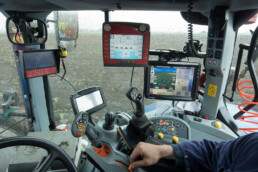The Role of GNSS Antennas in Precision Agriculture
GNSS antennas have become indispensable in precision agriculture, enabling farmers to work with greater accuracy and efficiency. By integrating high-precision antennas with GNSS systems, you can achieve detailed field mapping and soil sampling, allowing for tailored crop management. These antennas ensure that tractor guidance systems follow precise paths, minimizing overlap and reducing fuel consumption. The result is not only cost savings but also better resource allocation, as fertilizers, pesticides, and water are applied exactly where needed.
Another significant advantage is the ability to monitor and analyze field performance in real time. GNSS antennas provide the consistent, high-quality signal reception necessary for accurate data collection, even in challenging environments like dense vegetation or areas with limited satellite visibility. With this level of precision, you can make informed decisions that maximize yields while reducing environmental impact.
Enhancing Construction Project Efficiency with GNSS Antennas
In construction, accuracy and efficiency are critical to completing projects on time and within budget. GNSS antennas play a vital role in achieving these goals by enabling precise site surveying and machine control. Whether you’re grading a site, laying foundations, or managing heavy equipment, the reliable signal reception provided by GNSS antennas ensures that every movement is accurately tracked and executed. This reduces the risk of errors and eliminates the need for costly rework.
The integration of GNSS antennas into construction equipment also improves real-time data collection, helping you monitor progress and make adjustments on the go. These antennas are built to withstand harsh conditions, including extreme temperatures, vibrations, and dust, ensuring consistent performance throughout the project. By leveraging the capabilities of GNSS antennas, you can streamline workflows, improve safety, and accelerate project timelines, giving you a competitive edge in the industry.
Key Features of High-Precision GNSS Antennas
High-precision GNSS antennas are designed to deliver reliable and accurate performance in a wide range of applications. One critical feature is multi-frequency support, which allows antennas to receive signals from multiple satellite constellations simultaneously. This capability enhances accuracy and reduces signal degradation caused by obstructions, interference, or atmospheric conditions.
Durability is another important aspect. GNSS antennas used in agriculture and construction are often exposed to extreme weather, vibrations, and rough handling. To withstand these challenges, high-quality antennas are constructed with robust materials and weather-resistant enclosures, ensuring consistent performance over time. Additionally, a stable phase center—a feature of advanced antennas—minimizes measurement errors and ensures reliable positioning data, even in dynamic environments.
Selecting the Right GNSS Antenna for Agricultural Applications
Choosing the right GNSS antenna for agricultural tasks depends on the specific needs of your operation. For tractor guidance and precision planting, antennas with sub-meter accuracy and strong signal reception are ideal. These features ensure that every movement is executed with precision, reducing waste and maximizing efficiency.
When evaluating antennas, it’s important to consider compatibility with your existing machinery and software. Products available through Canal Geomatics, such as multi-frequency GNSS antennas with integrated signal filtering, are excellent options for farmers looking to enhance their precision agriculture systems. These antennas are built to handle the unique challenges of agricultural environments, providing reliable performance across large fields and varying conditions. By selecting the right GNSS antenna, you can optimize your processes and achieve better results season after season.
Choosing GNSS Antennas for Construction Projects
The demands of construction projects require GNSS antennas that deliver accuracy, durability, and seamless integration with modern equipment. When selecting an antenna for construction, it’s essential to prioritize models that can withstand harsh environments, including heavy vibrations, temperature extremes, and exposure to dust and moisture. These rugged features ensure consistent performance throughout the project lifecycle.
Accuracy is equally important, especially for applications like machine control and site surveying. Antennas that support multi-constellation and multi-frequency reception provide enhanced precision, reducing the risk of costly errors. Canal Geomatics offers a range of GNSS antennas that integrate seamlessly with construction equipment and software systems, ensuring compatibility and ease of use. By equipping your site with the right GNSS antennas, you can improve efficiency, reduce rework, and complete projects on schedule and within budget.
Installation and Maintenance Best Practices
Proper installation and regular maintenance of GNSS antennas are critical for achieving optimal performance. During installation, ensure that the antenna is mounted in a location with a clear view of the sky, free from obstructions like trees, buildings, or equipment. This setup maximizes signal reception and minimizes interference, providing the most accurate data possible.
Maintenance routines should include regular cleaning to remove dirt, debris, and any material that could degrade performance over time. Inspect connectors and cables for wear or damage, and replace components as needed to maintain a stable connection. Updating firmware and software ensures that your GNSS system remains compatible with the latest satellite technologies. Following these best practices will not only extend the lifespan of your antenna but also ensure consistent accuracy in both agricultural and construction applications.
Case Studies: Success Stories in Agriculture and Construction
The effectiveness of GNSS antennas is best demonstrated through real-world applications where they have significantly improved accuracy and efficiency. In agriculture, a large-scale farm implemented GNSS antennas for tractor guidance and crop management. The result was a dramatic reduction in fertilizer and pesticide use, leading to cost savings and improved environmental sustainability. With centimeter-level accuracy, the farm achieved higher yields and more efficient resource allocation, showcasing the transformative potential of GNSS technology.
In construction, a major infrastructure project utilized GNSS antennas for site surveying and machine control. The antennas provided precise positioning data, enabling automated equipment to perform tasks like grading and excavation with exceptional accuracy. This eliminated the need for manual rework and reduced project timelines by several weeks. These success stories highlight how GNSS antennas empower professionals in agriculture and construction to achieve superior outcomes with fewer resources.
Future Trends in GNSS Technology for Agriculture and Construction
As GNSS technology continues to evolve, its impact on agriculture and construction is set to grow. One significant trend is the development of antennas capable of multi-band and multi-constellation reception, further improving accuracy and reducing reliance on single systems. This advancement will enhance resilience in environments with challenging satellite visibility, such as urban construction sites or densely planted fields.
Another emerging innovation is the integration of GNSS antennas with IoT and AI technologies. This combination allows for real-time decision-making, predictive maintenance, and smarter workflows in both industries. Additionally, compact and lightweight antenna designs are becoming increasingly popular, enabling easier integration with drones, autonomous equipment, and portable devices. By staying ahead of these trends, professionals in agriculture and construction can continue to optimize their operations, ensuring greater productivity and sustainability.

